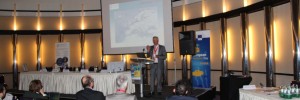The Sea Mammal Research Unit at the University of St Andrews is currently seeking a new Director. Details of the post and how to apply are given below. Description School of Biology, Scottish Oceans Institute (SOI), Sea Mammal Research Unit (SMRU), Starting Date: As soon as possible Details The Sea Mammal Research Unit (SMRU) is… Read more »
Posts By: Yota Antoniou
Euro-Argo ERIC inauguration event in Brussels
Source: http://www.euro-argo.eu/, EuroGOOS The official inauguration of Euro-Argo ERIC was hosted by the French Permanent Representation in Brussels on 17th July 2014. Euro-Argo is the European contribution to the international Argo array of 3,000 profiling floats (small autonomous robots), measuring temperature and salinity from the surface down to 2,000 m throughout the global oceans. This… Read more »
7th EuroGOOS Conference: programme out now
A draft programme of the 7th EuroGOOS Conference, which is going to be held at the Calouste Gulbenkian Foundation in Lisbon, 28-30 Oct, has been published. Click to view and download it. A more detailed programme will be published in the few coming weeks. The two and a half day Conference will include plenary, splinter… Read more »
OBIS data manager vacancy at IODE in Ostend
UNESCO/IOC-IODE is looking for a data manager to support the OBIS secretariat in Ostend (Belgium). Primary Location: UNESCO-IOC Project office for IODE, Ostend, Belgium Type of contract: Project Appointment (PA) Under the overall authority of the Executive Secretary of the Intergovernmental Oceanographic Commission of UNESCO and the direct supervision of the head of the IODE… Read more »
RITMARE SP5 “Observing system” meeting to be held back-to-back with 7th EuroGOOS Conference
EuroGOOS vice-Chair Alessandro Crise from OGS (Istituto Nazionale di Oceanografia e di Geofisica Sperimentale), leader of SP5 “Observing system” within the Italian RITMARE Project, is pleased to announce the RITMARE SP5 “Observing system” meeting to be held back-to-back with the 7th EuroGOOS conference in Lisbon. Date: 30-31 October 2014 – October 30, afternoon (2 pm… Read more »
The importance of an integrated end-to-end European Ocean Observing System: key message of EMD 2014

Source: EMD & EMODnet Secretariat Report from the joint EuroGOOS/EMODnet/EMB/JRC workshop at the European Maritime Day in Bremen, 19 May 2014: “From marine observations and data to information, knowledge and blue growth: towards an integrated end-to-end European Ocean Observing System (EOOS)” EuroGOOS Chair Dr. Erik Buch (left) and Head of EMODnet Secretariat… Read more »
RBINS-OD Nature installs autonomous radiometer system to measure ocean colour
Source: MUMM News and Announcements, 01 June 2014 RBINS – OD Nature, founding member of EuroGOOS, has recently installed an autonomous radiometer system on the offshore fixed platform MOW1 near Zeebrugge. This system measures the light that is reflected by the water in the visible and near-infrared spectral regions providing detailed information on the ocean… Read more »
Quality Assurance of Real Time Ocean Data: IOOS releases fifth manual
Source: U.S. IOOS As part of the U.S. IOOS Data Management and Communication (DMAC) core services, the U.S. IOOS Program Office has released the fifth QARTOD manual; Real-Time Quality Control of Water Level Data. This document represents significant progress towards more effective collection and processing of real-time water level observations using best-practices for quality control… Read more »
Conference: safer transport in the Mediterranean Sea
Source: cmcc.it, 26 May Safer transport in the Mediterranean Sea, Lecce, IT 27-28 May 2014 The conference is organized in the framework of the IONIO (IONian Integrated Marine Observatory) project, funded by the European Territorial Cooperation Operational Programme “Greece-Italy”, aimed at providing environmental information about the Southern Adriatic and Northern Ionian Area, to support safer… Read more »
Sonar spots invisible Arctic oil spills
Source: Scientific American, May 2014 The article speaks about how Arctic Ocean drilling may cause dangerous leaks under ice which are not visible by the eye but may be traced by sonars. Click here to read the full article.















































